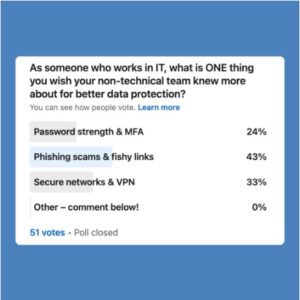Cyber Security: Phishing Scams & Fishy Links
|

The results from our LinkedIn poll are in! The #1 thing that IT professionals want their non-technical colleagues to know more about for better data protection is phishing scams and fishy links.
Here are a few things you need to know:
What is a phishing scam or fishy link?
According to the Federal Trade Commission, “Phishing is a type of online scam that targets consumers by sending them an e-mail that appears to be from a well-known source – an internet service provider, a bank, or a mortgage company, for example.” These scammers try to be enticing enough to fool individuals into providing personal information and end up wreaking havoc at work or within your personal life.
How do you spot email scams?
Here are some scenarios of potential e-mail scams (provided by the FTC):
– If someone says they’ve noticed suspicious activity or log-in attempts on your account
– If someone claims there’s a problem with your account or your payment information
– If someone says you need to confirm personal or financial information
– If someone sends an unrecognizable invoice
– If someone wants you to click on a link to make a payment
– If someone says you’re eligible to register for a government refund
– If someone offers you a coupon for free stuff
– If the e-mail has a generic greeting
– If the e-mail says your account is on hold because of a billing problem
– If the e-mail invites you to click on a link to update your payment details
It’s important to remember that scammers might use familiar names, e-mails, or logos to blend in with your regular business contacts. If anything seems off, it probably is. Go about it cautiously–it’s better to be safe than sorry.
What should you do if you receive one?
Report any scam messages – If you give in to a scam, contact the proper authorities. If you provided account or credit card information, contact the companies directly and let them know what happened.
Block – After you report them, block and delete the messages to prevent anything from happening again.
Do not click – If you don’t recognize the sender and aren’t expecting a request from anyone, do NOT click any links or provide any information.
Run a scan – If you have protection software on your device, run a scan to check for any unwanted downloads or malware.
How can you prevent being scammed?
- Download software that helps you protect your devices. Perform frequent or automatic updates to keep up with the best security standards.
- Utilize multi-factor authentication (MFA). This way, if someone tries to log in to your account, there will be multiple barriers to entering, and you will be notified.
- Back up your information. Use automatic back-ups to keep your saved information up-to-date and use cloud storage.
- Hire information technology professionals. Increase leadership to guide your company towards better data protection and reduce the risk of threats.
- Stay up-to-date- about the latest scamming trends and be aware when clicking links from questionable senders.
Don’t be embarrassed if you fall for a phishing scam. These can be very enticing and often successful. Just more of a reason you should be proactive and stay informed.
Need assistance building a solid technical team? Contact us!
Leave a Reply


